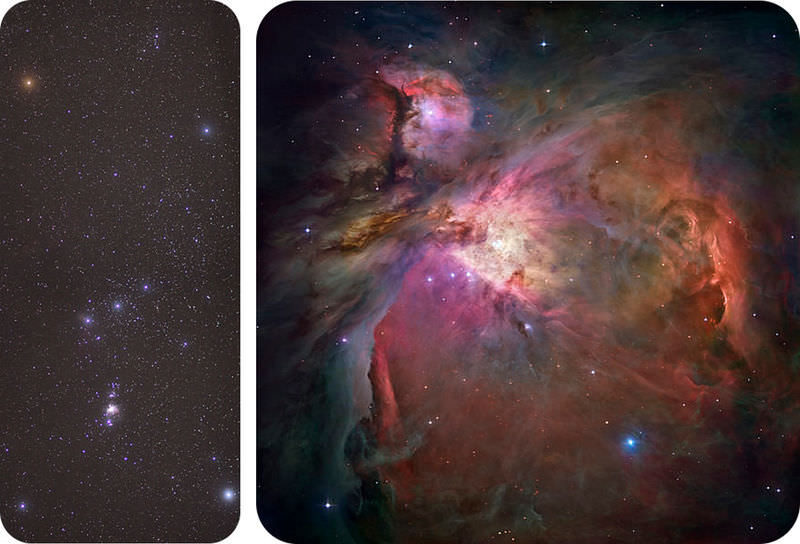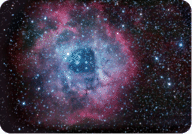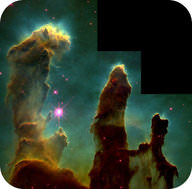23.4: Formación Estelar
- Page ID
- 109511
¿Se ve nacer estrellas?
En una noche oscura prácticamente se puede ver nacer a las estrellas. El área difusa en la espada en la constelación de Orión es la nebulosa de Orión. Un primer plano muestra la nebulosa con alrededor de 3 mil estrellas. Ahí están naciendo nuevas estrellas.
Vidas estelares
Las estrellas tienen un ciclo de vida, al igual que las personas. Las estrellas nacen, crecen, cambian con el tiempo, y eventualmente envejecen y mueren. La mayoría de las estrellas cambian de tamaño, color y clase al menos una vez en su vida. Lo que saben los astrónomos sobre los ciclos de vida de las estrellas proviene de los datos recopilados de telescopios visuales, de radio y de rayos X.
Nebulosas
Las estrellas nacen en una nube de gas y polvo llamada nebulosa (Figura abajo). Nuestro Sol y sistema solar se formaron a partir de una nebulosa.
Se están formando estrellas en la Nebulosa Rosette.
Los Pilares de la Creación (Figura abajo) se encuentran dentro de la Nebulosa Águila. Se piensa que los pilares son una gran región donde se forman las estrellas. Las zonas oscuras pueden ser estrellas que están a punto de comenzar.
En los Pilares de la Creación, el gas y el polvo se unen como vivero estelar.
Formación Estelar
Para que se forme una estrella, la gravedad tira gas y polvo hacia el centro de la nebulosa. A medida que el material se vuelve más denso, la presión y la temperatura aumentan. Cuando la temperatura del centro se calienta lo suficiente, comienza la fusión nuclear. ¡La bola de gas se ha convertido en una estrella!
Nuestro Sol probablemente nació en una nebulosa, como Orión en la imagen superior.
Resumen
- Las estrellas se forman en una nebulosa.
- Una nebulosa es una nube de polvo y gas.
- Las nebulosas se pueden ver a simple vista o con simples telescopios.
Revisar
- ¿Qué es una nebulosa?
- ¿Cómo se forman las estrellas?
- ¿Por qué los científicos piensan que los Pilares de la Creación son donde se forman las estrellas?
Referencias
| Imagen | Referencia | Atribuciones |
|---|---|---|
 |
[Figura 1] |
Crédito: Cortesía de NASA, Jeff Hester, y Paul Scowen (Universidad Estatal de Arizona); Por Tyrogthekreeper en Wikipedia en inglés, CC BY-SA 3.0, commons.wikimedia.org/w/inde... 10273; Cortesía de H. Bond (STSci), y M. Barstow (Universidad de Leicester), NASA/ESA Fuente: Commons.wikimedia.org/wiki/Archivo:Eagle_Nebula_Pillars.jpg; Por Tyrogthekreeper en Wikipedia en inglés; CC BY-SA 3.0; commons.wikimedia.org/w/index. php//curid=18110273; commons.wikimedia.org/wiki/Archivo:Sirius_a_and_b_hubble_photo.jpg Licencia: Dominio público |
 |
[Figura 2] |
Crédito: John Lanoue; CC BY-SA 3.0, commons.wikimedia.org/w/inde... ry/622142.html Fuente: commons.wikimedia.org/wiki/Archivo:rosette_nebula_lanoue.png; CC BY-SA 3.0; commons.wikimedia.org/w/index. php//curid=230867; http://keywordsuggest.org/gallery/622142.html Licencia: Dominio público |
 |
[Figura 3] |
Crédito: Cortesía de NASA, Jeff Hester, y Paul Scowen (Universidad Estatal de Arizona); CC BY-SA 3.0, commons.wikimedia.org/w/inde... urid=230867; Por Crédito: NASA, Jeff Hester, y Paul Scowen (Universidad Estatal de Arizona) - http://hubblesite.org/newscenter/new...003/34/image/a, Dominio Público, commons.wikimedia.org/w/inde... p? curid=129538 Fuente: Commons.wikimedia.org/wiki/Archivo:Eagle_Nebula_Pillars.jpg; CC BY-SA 3.0; commons.wikimedia.org/w/index. php//curid=230867; Por Crédito: NASA; Jeff Hester; y Paul Scowen (Universidad Estatal de Arizona) - http://hubblesite.org/newscenter/new...003/34/image/a; Dominio público; commons.wikimedia.org/w/index. phptwitter.com/curid=129538 Licencia: Dominio público |



